Posted by: Northwest Eye in General on September 16, 2025
Overview
A 1.00 eye prescription is generally not considered bad. In fact, it typically indicates mild refractive errors that can be effectively managed with appropriate treatment. We understand that you may have concerns about your eye health, and we want to reassure you that regular eye examinations and personalized care are essential. These measures can help address any symptoms you might experience, such as blurred vision or frequent headaches. Our goal is to ensure your optimal eye health and clarity.
It’s common to feel uncertain about what a prescription means for your vision. Remember, you are not alone in this journey. Many patients have experienced similar situations and have found comfort in knowing that there are effective solutions available. We encourage you to seek regular eye check-ups, as they play a vital role in maintaining your vision and overall well-being.
Your eye health matters to us, and we are here to help you through this process. By taking proactive steps and seeking the right care, you can achieve clarity and comfort in your vision.
Introduction
Concerns about eye health often lead to important questions regarding the significance of a 1.00 eye prescription. While this level of refractive error may seem minor, it’s essential to recognize that it can indicate underlying issues affecting visual clarity and comfort.
We understand that this might raise concerns, and it’s common to wonder what signs to watch for. Key indicators such as:
- Headaches
- Blurred vision
- Dry eyes
may suggest that an update to your prescription is necessary.
So, how can you determine whether a 1.00 eye prescription is truly a cause for concern? What steps should you take to ensure optimal eye health? We are here to help you through this process.
Northwest Eye: Expert Evaluation for Your 1.00 Eye Prescription
At Northwest Eye, we understand that patients may have concerns about their eye health regarding a – 1.00 eye prescription how bad is that. Our experienced ophthalmic surgeons conduct thorough assessments to ensure that every patient receives the best possible care. This degree of recommendation typically indicates mild refractive errors, which can be effectively addressed through personalized treatment plans, particularly for those wondering – 1.00 eye prescription how bad is that.
Our commitment to patient-focused care means that you will receive advice and solutions designed to improve your sight and overall eye health. Recent advancements in eye care, such as the innovative Light Adjustable Lens (LAL) technology and specialized presbyopia packages, have further improved outcomes for those with mild refractive errors. We want you to know that achieving optimal visual clarity is within reach.
As leading ophthalmologists, including Isabel Signes-Soler, emphasize, early intervention and tailored treatment strategies are crucial for managing these conditions effectively. This approach ultimately leads to successful outcomes and an improved quality of life for our patients. With the global estimate of amblyopia prevalence at 1.36%, it’s common to feel a sense of urgency. We encourage you to seek evaluations and treatments promptly to address any refractive errors. Remember, we are here to help you through this process.
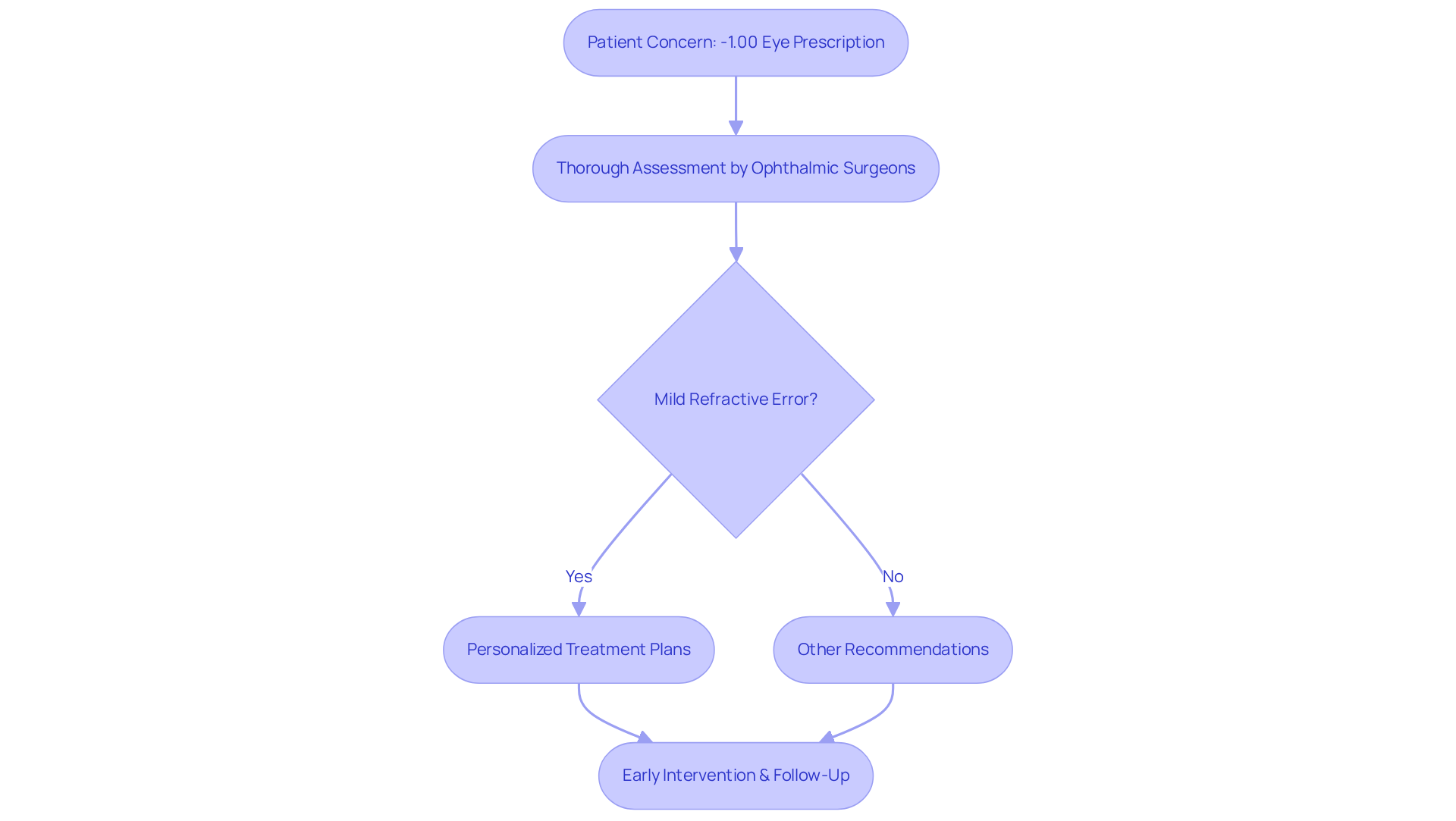
Frequent Headaches: A Sign of Prescription Problems
Frequent headaches can be a significant indicator of underlying eye issues, especially if:
- 1.00 eye prescription how bad is that is outdated or incorrect.
We understand that dealing with headaches can be frustrating, and studies show that many patients experience headaches directly linked to eyesight problems, especially those who have a:
- 1.00 eye prescription how bad is that.
When your vision struggles to focus, it can lead to strain, resulting in discomfort and headaches. You may also notice common symptoms like blurred sight, dry eyes, and discomfort, which can indicate conditions such as cataracts, diabetic retinopathy, or uncorrected refractive errors.
Eye care professionals emphasize the importance of regular check-ups to identify these issues early. At Northwest Eye, we are here to help you through this process. Our thorough assessments can uncover the underlying reasons for your headaches and offer personalized corrective solutions, ensuring your sight and overall health are prioritized. By addressing medication issues promptly and implementing strategies like the 20-20-20 rule—taking a 20-second break to look at something 20 feet away every 20 minutes—you can alleviate the discomfort associated with eye strain and improve your quality of life. Remember, we are committed to supporting you every step of the way.
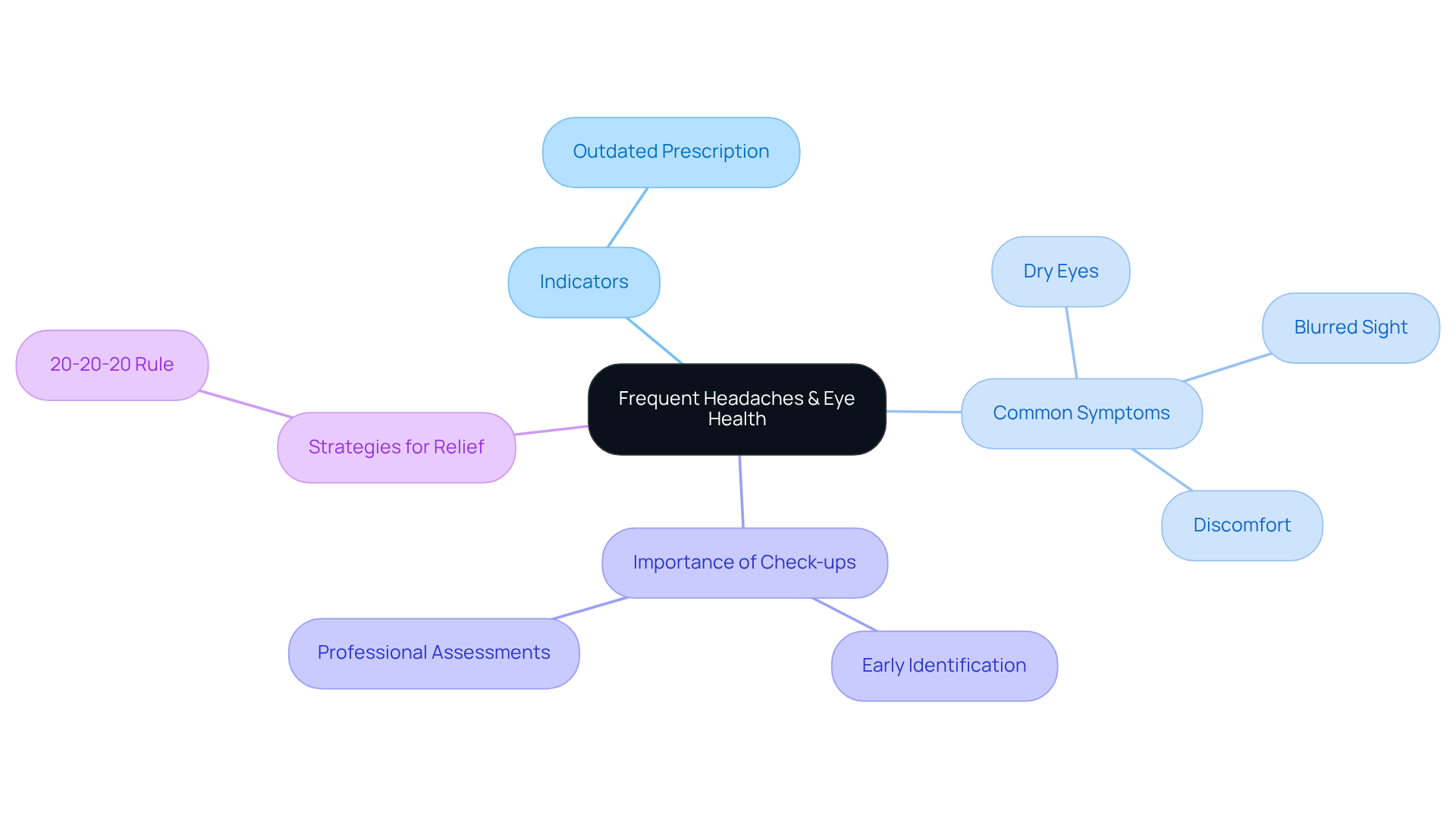
Blurred Vision: Understanding Its Connection to Your Prescription
Blurred sight can be concerning, often indicating that your current eye correction may not meet your needs. While a 1.00 eyewear recommendation might seem minor, understanding a 1.00 eye prescription how bad is that is important if there are any noticeable changes in clarity worth discussing with an eye care professional. We understand that many patients have experienced significant improvements in their vision clarity after updating their eyewear recommendations, underscoring the vital role of precise eye care.
At Northwest Eye, we are dedicated to providing comprehensive eye examinations designed to thoroughly assess your vision and determine if adjustments are necessary to restore optimal clarity. It’s common to feel uncertain about your eye health, especially if you are experiencing blurred sight. Routine eye check-ups are essential, as they can help detect underlying issues and ensure that your eyewear needs are current.
We are here to help you through this process, ensuring you receive the care and support you deserve.
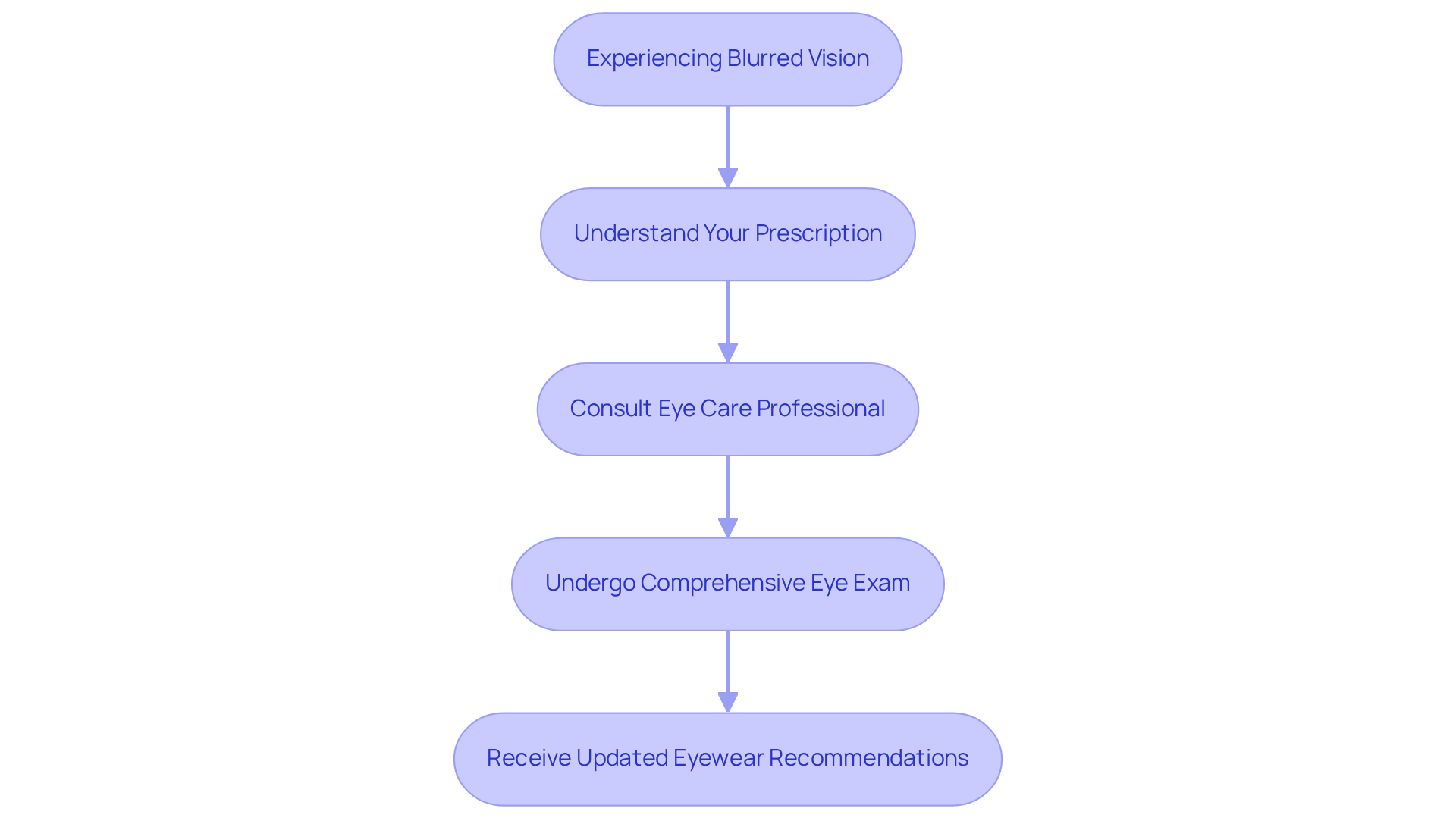
Irregular Eye Exams: Missing Signs of Prescription Changes
Neglecting routine eye examinations can lead to unnoticed changes in your vision, including the need for new eyewear. At Northwest Eye, we understand how important your eye health is, and we encourage you to schedule annual exams with our Certified Opticians. This proactive approach helps catch any shifts in your eye health early, ensuring you receive personalized assistance tailored to your needs.
We prioritize your safety and comfort during your visit. Our commitment to maintaining safety protocols, including disinfecting all touch surfaces, allows you to feel secure. Additionally, for your convenience, you can order contact lenses online, making it easier to manage your eye care.
By remaining attentive to your eye health, you can avoid complications and ensure optimal vision. Remember, we are here to help you through this process, and your well-being is our top priority.
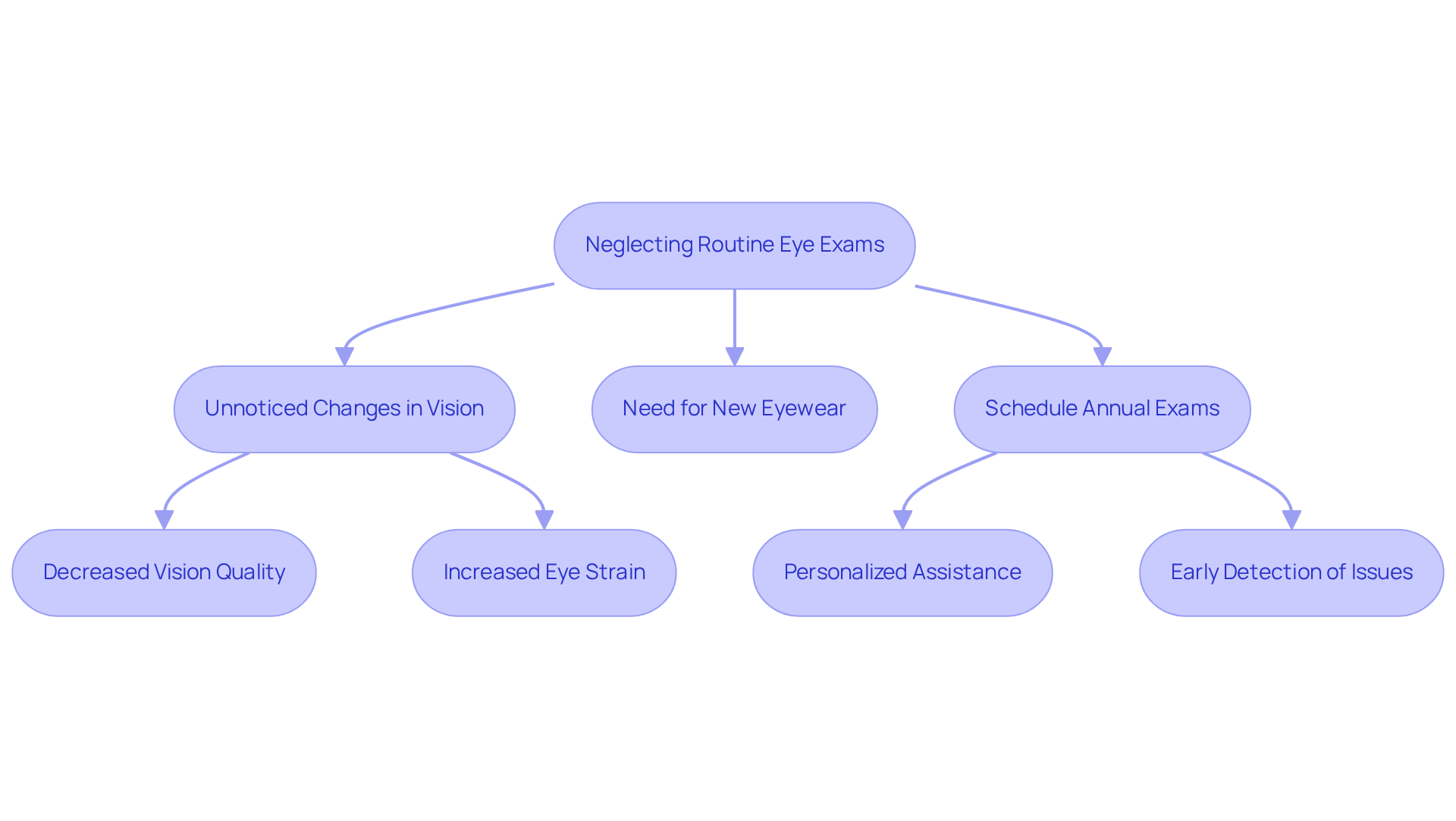
Persistent Dry Eyes: A Warning for Your Eye Health
Persistent dry eyes can indicate that your current eye prescription, specifically a – 1.00 eye prescription how bad is that, may not be meeting your needs adequately. We understand that this condition, if overlooked, can lead to discomfort and potentially worsen eye issues. Dry Eye Syndrome affects between 16.7 million and 50.2 million Americans, costing the U.S. economy over $55.4 billion annually. Many individuals experience symptoms such as stinging, burning, and blurred vision, and it’s common to feel frustrated by these challenges.
At Northwest Eye, we are here to help you through this process. We provide specialized treatments to tackle dry eyes, including medicated eye drops and advanced therapies customized to your individual symptoms. Our Minnesota Dry Eye doctors utilize innovative solutions such as punctal plugs, which help retain moisture on the eye surface. This procedure typically costs between $250 and $500.
Initial treatments involve assessing your lifestyle and work routines to better manage your symptoms. By concentrating on individualized care, Northwest Eye ensures that every patient receives the attention needed to enhance their overall eye health. Additionally, we treat a variety of other eye conditions, ensuring comprehensive care for all our patients. You are not alone in this journey, and we are committed to supporting you every step of the way.
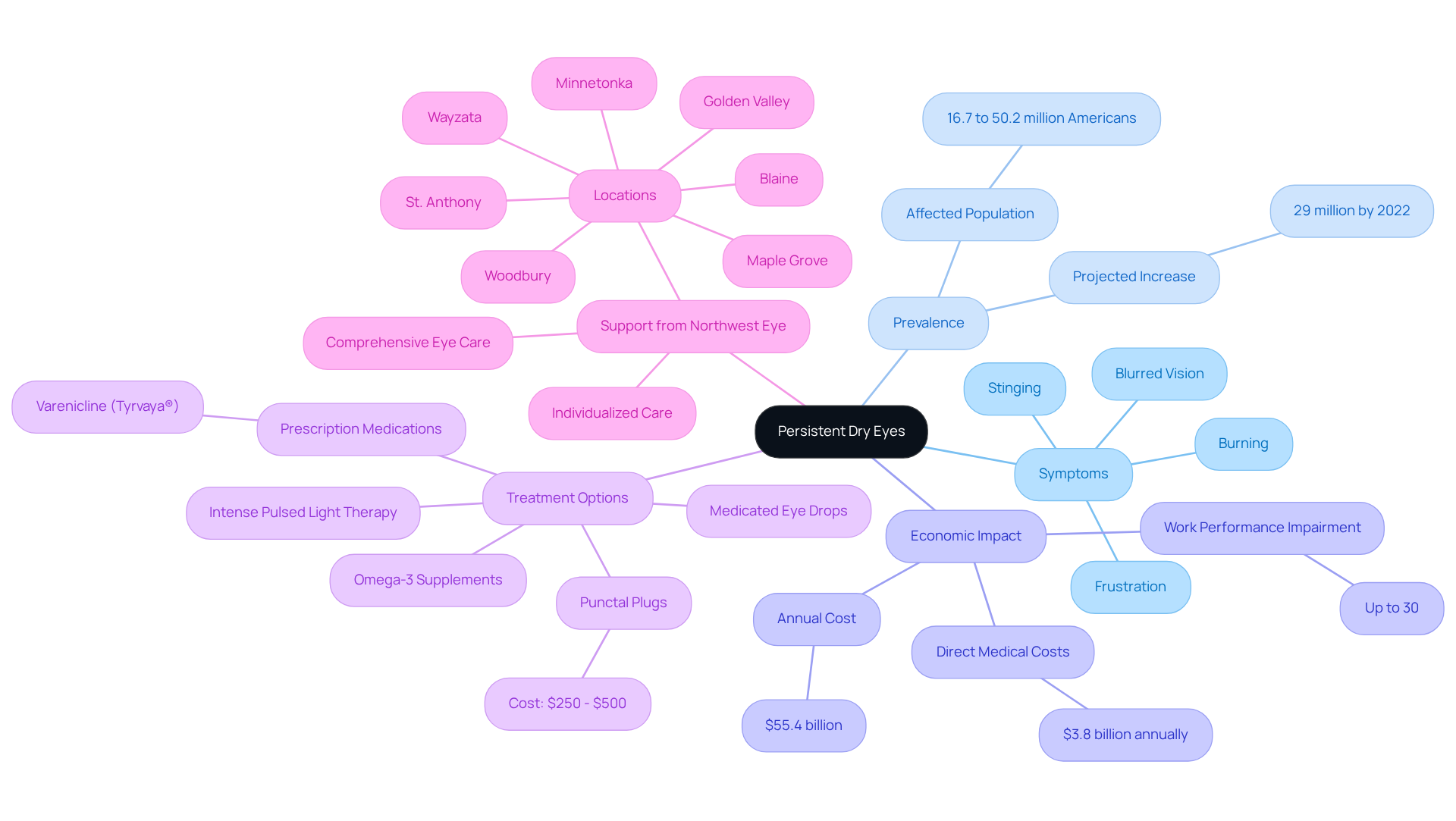
Difficulty Focusing: Recognizing a Potential Prescription Issue
If you’re finding it difficult to concentrate on items, we understand that this can be concerning. It may be time to reconsider your eye correction if you are questioning – 1.00 eye prescription how bad is that. This symptom can arise from various factors, such as changes in your eyesight, an outdated lens prescription, or conditions like blurred vision, which might indicate underlying issues such as cataracts, diabetic retinopathy, or uncorrected refractive errors, raising the question of – 1.00 eye prescription how bad is that.
At Northwest Eye, we are here to help you through this process. Our dedicated team can determine the cause of your focusing difficulties and provide tailored solutions to improve your sight. We encourage you to schedule an appointment for a professional evaluation. Only a Northwest Eye doctor can offer an accurate diagnosis and recommend the most appropriate treatment options.
Please rest assured that we continue to uphold safety protocols in our optical department to ensure your well-being during your visit. Your health and comfort are our top priorities.
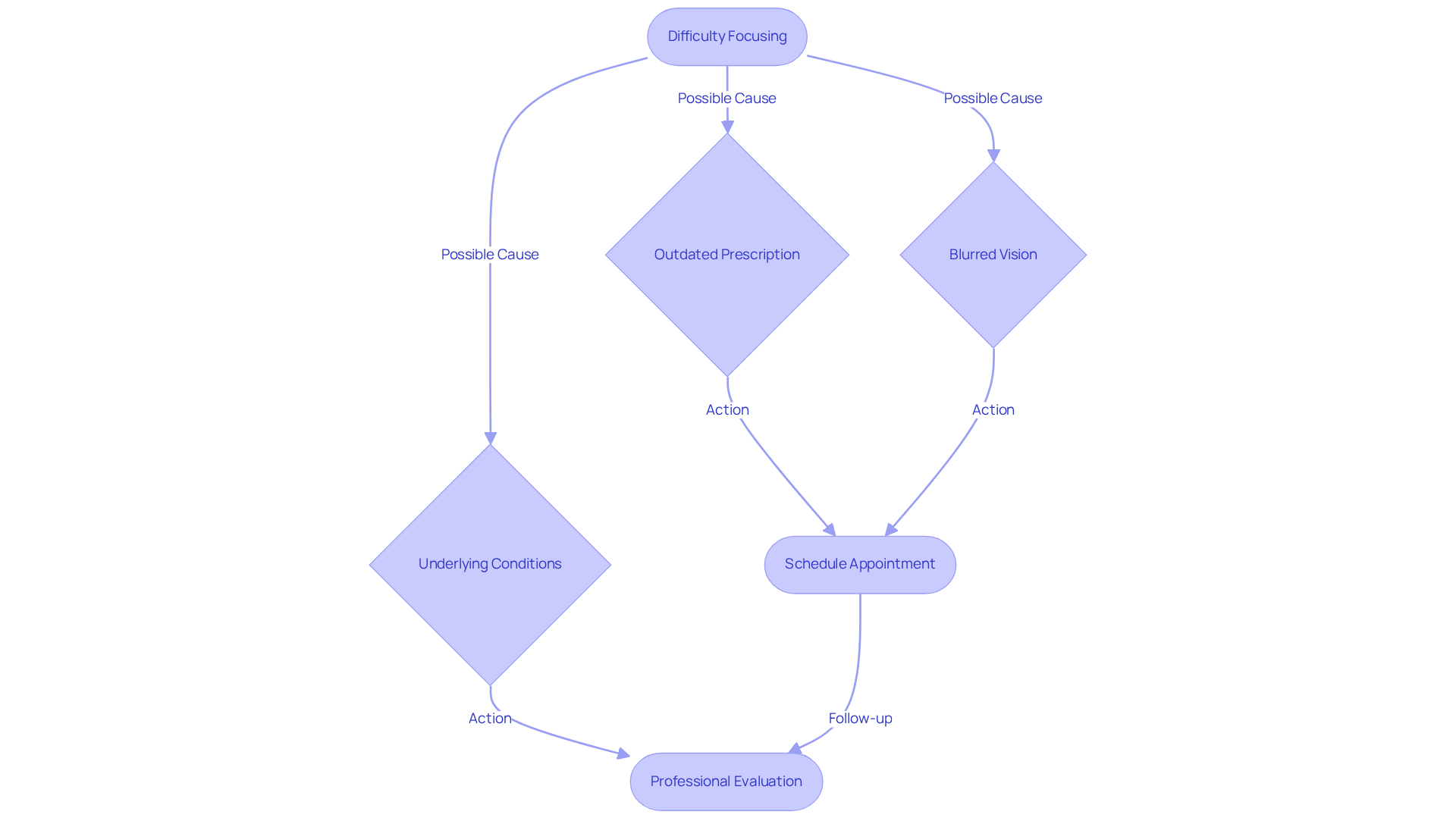
Visual Fatigue: A Key Indicator of Prescription Problems
Visual fatigue can be a frustrating experience, often marked by tired or strained vision. If you find yourself squinting or feeling discomfort after prolonged visual tasks, we understand how concerning that can be. It’s essential to consult with an eye care professional. At Northwest Eye, our specialists emphasize the importance of understanding the reasons behind blurred sight, which can stem from various conditions such as:
- nearsightedness
- astigmatism
- cataracts
- diabetic retinopathy
- dry eyes
- macular degeneration
We specifically address concerns like: 1.00 eye prescription how bad is that.
We are here to help you through this process, providing thorough evaluations to determine the best course of action for alleviating visual fatigue and improving your overall eye health. Untreated symptoms can lead to serious health complications, making it crucial to seek professional help. Our innovative Light Adjustable Lens offers a unique solution for cataract patients, ensuring that your sight is tailored to your specific needs. Remember, you are not alone in this journey, and we are committed to supporting you every step of the way.
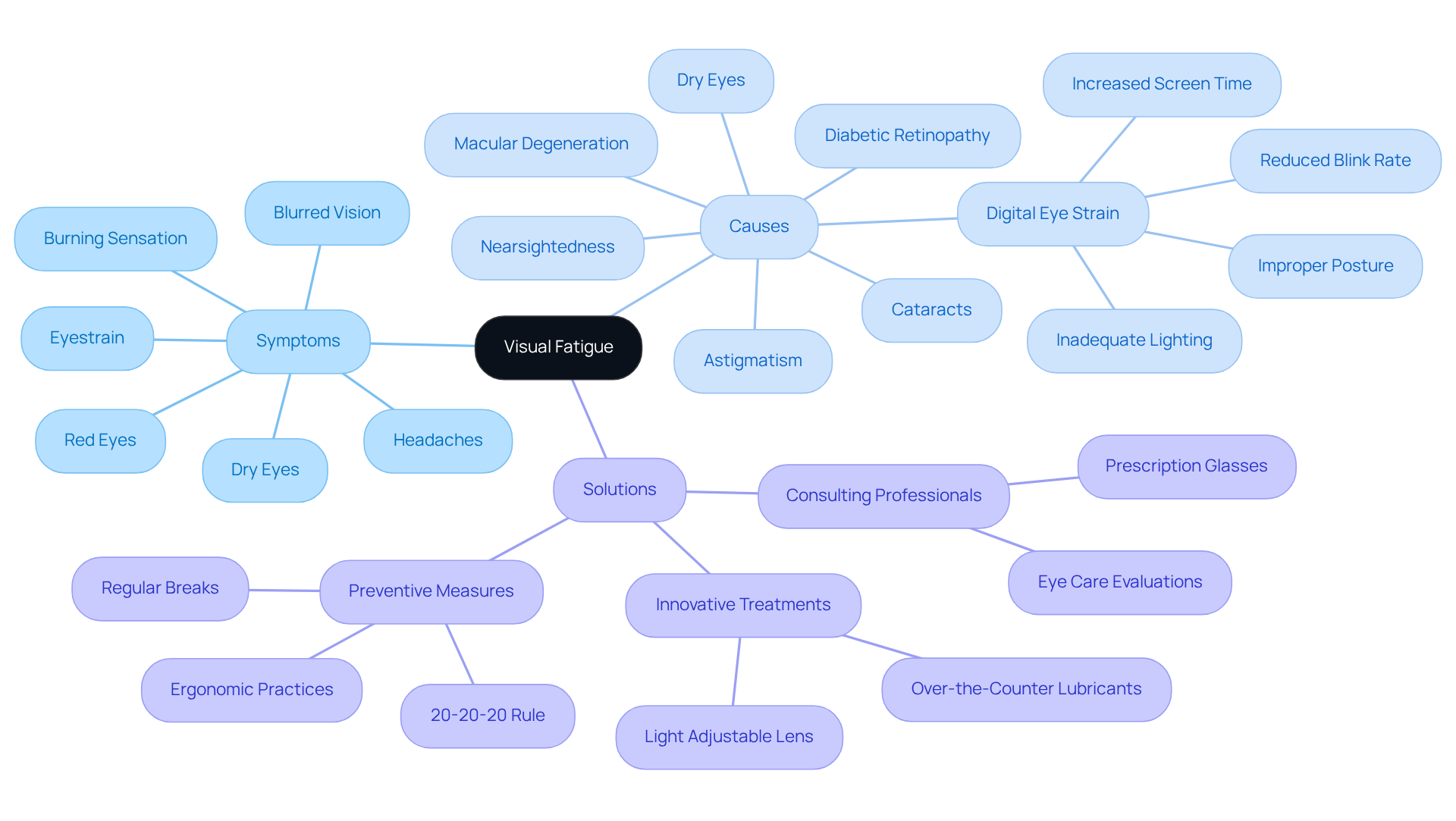
Night Vision Changes: Assessing Your Eye Prescription
If you notice changes in your night vision, such as increased difficulty seeing in dim light, it’s important to understand that your eyewear might not be meeting your needs anymore. This concern is particularly significant for those asking – 1.00 eye prescription how bad is that, as even minor changes can impact your clarity at night. At Northwest Eye, we understand how crucial it is for you to feel confident in your vision. That’s why we offer specialized evaluations to ensure your glasses are equipped to handle all lighting conditions.
Our comprehensive eye care services include advanced treatments for various eye conditions, such as:
- cataracts
- dry eye
- LASIK
We also provide innovative options like the Light Adjustable Lens, ensuring that you receive the highest quality care tailored to your unique vision requirements. Remember, we are here to help you through this process, offering support every step of the way.
Age-Related Vision Changes: Implications for Your Prescription
As we grow older, we understand that our sight naturally evolves, which can greatly affect your eye requirements. For instance, a – 1.00 eye prescription how bad is that may become less effective over time, particularly with the onset of presbyopia, a common condition that affects nearly everyone by age 40. It’s common to feel concerned about blurred vision, which can result from various abnormalities such as nearsightedness, farsightedness, presbyopia, and a – 1.00 eye prescription; how bad is that? This may also signal the presence of eye diseases like cataracts, diabetic retinopathy, or macular degeneration.
Most glasses recommendations expire after 1-2 years, highlighting the necessity for regular updates. We encourage you to schedule regular check-ups at Northwest Eye, as these are essential for monitoring changes in your vision. Adults aged 65 and older should have annual eye exams due to an increased risk of age-related conditions. Ophthalmologists stress that understanding updates to eye care is vital for maintaining your visual health, especially as age-related issues like presbyopia develop.
If you experience symptoms of blurred sight, it’s important to seek professional assistance, as ignoring these symptoms can lead to serious health issues. We have seen practical instances where patients effectively managed their eyesight by revising their eyewear orders. One patient expressed gratitude for their updated prescription, noting it significantly improved their clarity and comfort in daily activities.
Furthermore, chronic conditions like diabetes and high blood pressure can complicate changes in eyesight, making it even more important to prioritize regular eye exams. By ensuring consistent monitoring, you can maintain clear sight and effectively manage your eye health. Remember, we are here to help you through this process.
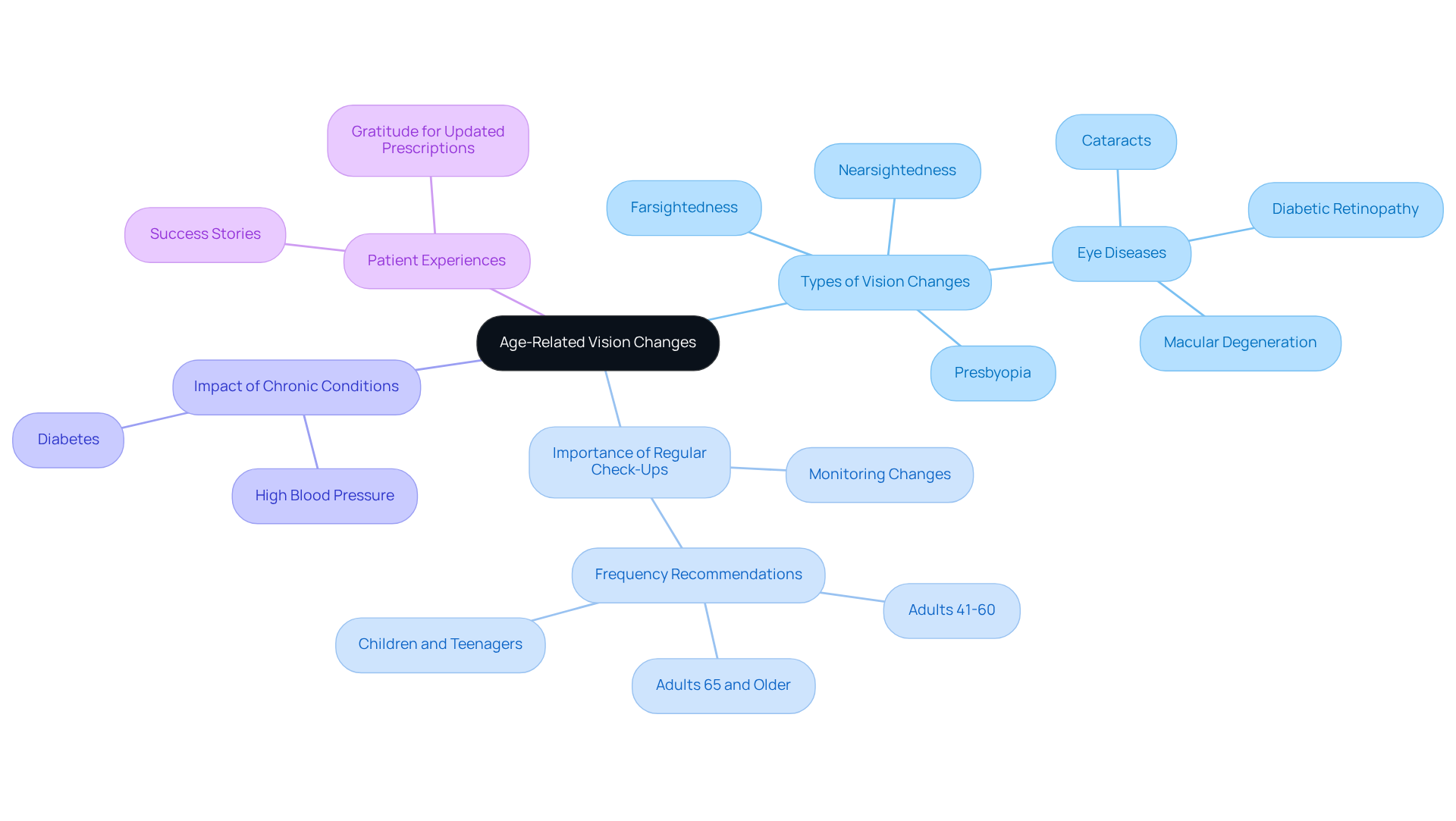
Patient Education: Empowering You to Understand Your Eye Health
At Northwest Eye, we understand that your eye health is a significant concern. Patient education is our top priority, and we are here to provide you with the resources and information you need. We want to help you understand your eye health, including the implications of your prescription and the potential impact of conditions like conjunctivitis, especially considering:
- 1.00 eye prescription – how bad is that in relation to COVID-19.
By empowering you with knowledge about common eye symptoms and the importance of professional diagnosis, we aim to foster proactive engagement in your eye care journey. It’s common to feel overwhelmed by health information, but we are here to guide you every step of the way. This ensures that you can make informed decisions about your vision and overall eye health.
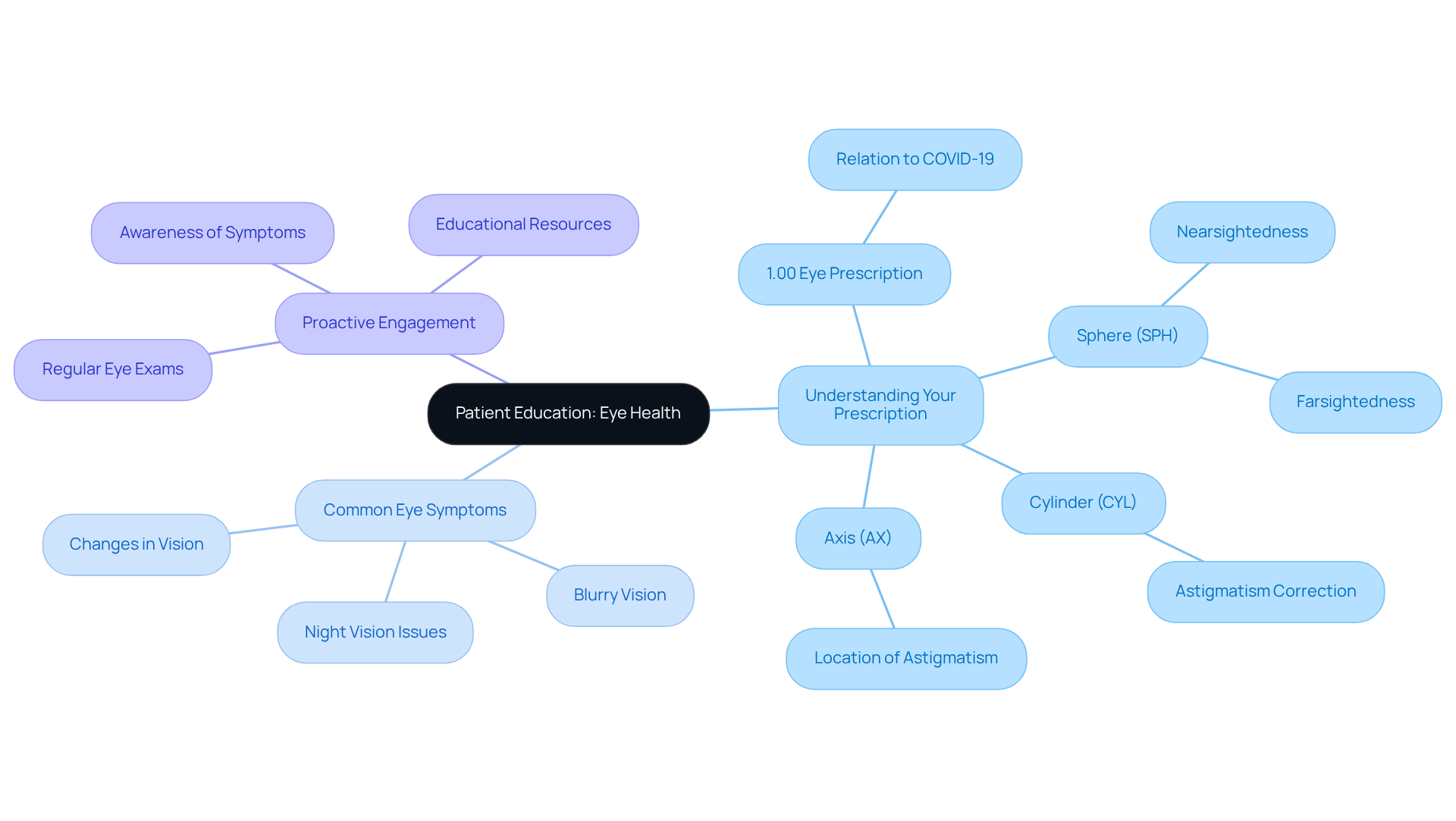
Conclusion
A -1.00 eye prescription may seem minor, but it can significantly impact your visual clarity and overall eye health. We understand that recognizing the implications of such a prescription is crucial, especially when symptoms like frequent headaches, blurred vision, and persistent dry eyes arise. These signs often indicate that a reevaluation of your prescription is necessary, highlighting the importance of proactive eye care and regular check-ups.
Key insights from the article emphasize the connection between a -1.00 prescription and various visual challenges:
- Frequent headaches can stem from uncorrected refractive errors.
- Blurred vision often signals that your current eyewear may no longer be effective.
It’s common to feel overwhelmed, but neglecting routine eye exams can lead to missed opportunities for timely intervention, which is essential for maintaining optimal vision. Moreover, age-related changes and conditions can exacerbate these issues, underscoring the necessity for regular assessments.
Ultimately, prioritizing your eye health through education and professional evaluations is vital. By staying informed and seeking timely assistance from eye care professionals, you can effectively manage your vision and prevent complications. Regular check-ups not only address current concerns but also empower you to understand your eye health better, fostering a proactive approach to maintaining clear sight and overall well-being.
Frequently Asked Questions
What does a 1.00 eye prescription indicate about eye health?
A 1.00 eye prescription typically indicates mild refractive errors, which can be effectively addressed through personalized treatment plans.
How can Northwest Eye help with a 1.00 eye prescription?
Northwest Eye offers thorough assessments and personalized treatment plans to improve sight and overall eye health, utilizing recent advancements in eye care technology.
Why is early intervention important for managing eye conditions?
Early intervention and tailored treatment strategies are crucial for effectively managing eye conditions, leading to successful outcomes and improved quality of life for patients.
What symptoms might indicate that my eye prescription is outdated or incorrect?
Symptoms may include frequent headaches, blurred sight, dry eyes, and discomfort, which can indicate underlying eye issues related to an outdated prescription.
How can frequent headaches be linked to vision problems?
Frequent headaches can occur when vision struggles to focus, leading to eye strain and discomfort, particularly if the eye prescription is outdated or incorrect.
What should I do if I experience blurred vision?
If you experience blurred vision, it is important to discuss any noticeable changes with an eye care professional, as it may indicate that your current eye correction needs adjustment.
How often should I have my eyes checked?
Regular check-ups are essential to identify underlying issues early and ensure that your eyewear needs are current.
What strategies can help alleviate discomfort associated with eye strain?
Implementing strategies like the 20-20-20 rule—taking a 20-second break to look at something 20 feet away every 20 minutes—can help alleviate discomfort from eye strain.






